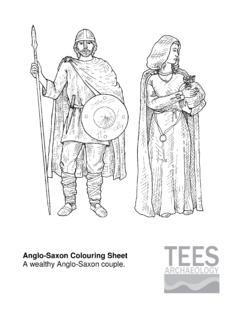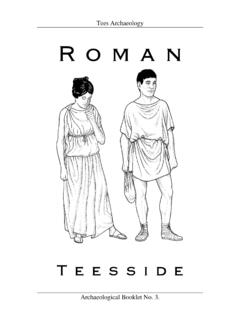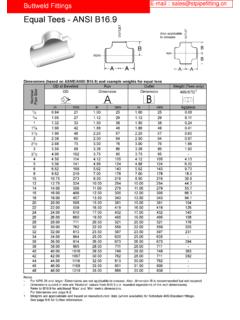Transcription of The Buildings of Stockton-on-Tees
1 tees ARCHAEOLOGY THE Buildings OF Stockton-on-Tees The Town of Stockton-on-Tees and its Buildings Robin Daniels tees Archaeology tees Archaeology 2014 The Town of Stockton-on-Tees and its Buildings Contents List of Figures Acknowledgements Introduction Looking at Buildings The Development of stockton Medieval Buildings of the Town The 17th and 18th Century Town 19th Century Buildings Impact of the 20th Century Conclusion List of Figures Centre Pages. Map of stockton showing the position of Buildings 1. Plan showing the Medieval Village, Town and Castle of stockton 2. Sketch of the Castle in 1647 3. Bolton Castle, Wensleydale 4. 17th century building , Whitby 5. 17th century stone Buildings , Finkle Street 6. 18th and 19th century brickwork 7. Early 18th century houses on Silver Street 8. Early 18th century housing on the High Street 9. Number 153 High Street 10.
2 Number 153 High Street detail of windows and bonding 11. 18th century Rectory, 148/149 High Street 12. 32 Dovecot Street (copyright Peter Moon) 13. 16 Church Road 14. Former warehouses at Green Dragon Yard 15. Calvin House, Green Dragon Yard 16. Town House from the south 17. stockton Parish Church from the west 18. Mid 19th century terraced housing, Victoria Terrace, Norton Road 19. Late 19th century terrace, Norton Road 20. 19th century town house, 111 High Street 21. 19th century double pile, 161/162 High Street 22. Pots, 22 Dovecot Street 23. The Shambles, built 1825 24. Clephan North End Engineering Works, Norton Road 25. 19th century warehouse, Blue Post Yard 26. 136 High Street 27. 37 High Street 28. 12 Prince Regent Street 29. The Red Lion, Ramsgate 30. NatWest Bank, 123/124 High Street 31. Yorkshire Bank, 46 High Street 32. 126 High Street 33. 41 High Street 34. tees House, 106 High Street 35. Debenhams Department Store, 150/151 High Street 36.
3 The North Eastern, 163 High Street 37. 143 High Street 38. 4 High Street 39. Former Globe Theatre, 154/157 High Street 40. Detail of former Globe Theatre, 154/157 High Street 41. 119 High Street 42. 159/160 High Street 43. 3/9 Bishopton Lane 44. stockton Library and Municipal Buildings Acknowledgements This booklet could not have been produced without the help of all the volunteers who took part in the stockton building Recording Project between 2009 and 2013. Each year a week of recording took place and in total 42 volunteers provided 138 days work and recorded 343 Buildings . Particular thanks must go to Alan Betteney who attended every session and put his vast knowledge of stockton at the disposal of the project. I would also like to thank Keith Pratt who attended all but one session and made a great contribution to the project. stockton Borough Council supported the project throughout, proving accommodation, mapping and funding through grants for Heritage building projects (funded by stockton Borough Council, English Heritage and the Heritage Lottery Fund).
4 The map was produced by Rachel Grahame of tees Archaeology and the text of this booklet was commented on by Fiona Bage, Suzanne Calvert and Alan Betteney. 1 Introduction This booklet outlines the history of Stockton-on-Tees and draws attention to the way Buildings that can be seen today illustrate the history of the town and the periods when they were built. This booklet has been produced as part of the Central stockton Townscape Heritage Initiative, which is funded by stockton Borough Council and the Heritage Lottery Fund. The project is designed to preserve and improve the historic environment of part of the town. As part of this project local volunteers worked with tees Archaeology to record and create a snapshot in time of the Buildings in the town s historic core. This record includes digital images of all the Buildings , whatever their date and importance and a brief written report on each building . The complete archive of this building recording in stockton Town Centre is held by tees Archaeology and stockton Borough Council library, museum and planning services.
5 2 Looking at Buildings The key to looking at the Buildings of stockton is to look above the shop fronts. When you do you will see a wide variety of building sizes and shapes with windows of different designs and an assortment of decorative styles. These all bear witness to the different periods in the development of the town, from early 18th century townhouses to 19th century terraced housing, late 19th century commercial premises and a range of 20th century structures. The variety of Buildings in stockton makes it a particularly interesting town. The majority of Buildings are built of brick, but if you look closely you will see different sizes, shapes and colours. The earliest brick is small and thin with a lighter or very mottled colour and no two are exactly the same. As time passes bricks become larger and virtually identical. Windows follow a similar progression 17th and 18th century windows tend to be made of many small panes of glass and as the technology developed larger sheets of glass were used until we get to the huge sheets that are available today.
6 Always check for old names and dates, although date stones can often be returned to a re-built structure. Look at the drain pipes and gutters and particularly at the hoppers at the top of the drain pipes; you will often see dates or designs on these. 3 The Development of stockton The present historic core of stockton has three parts: the former site of the castle at the south end of the High Street; the Medieval Borough, extending from the former site of the castle to Dovecot Street and a Medieval Village which was probably sited in the area of the present Parish Church. These three components continue to shape the development of the town. The Medieval Village of stockton The Medieval Village was the oldest part of stockton . It is recorded in the Boldon Book of 1183 AD and may already have existed for about a century (Austin 1982). As well as the village, the site of an old hall is recorded and this would have belonged to the Bishop of Durham who owned stockton .
7 The old hall was not in the same position as the later castle. The Norman Conquest of the North of England was completed about 1100 AD. The Normans then started to re-build the region creating villages and towns. These villages, of which stockton was one, were built to a plan of two parallel rows of farms with a broad street or green between and the fields laid out around the village. The village of stockton was described in 1183 as having eighteen farms, three families with a cottage but little land, a smith and a ferry across the River tees (Austin 1982, 54-55). The people holding the land were a mix of peasant farmers, tied to the land and to the Bishop, and leaseholders who paid rent but otherwise had fewer obligations. 4 Fig 1: Plan showing the Medieval Village, Town and Castle of stockton . The underlying map dates from 1826. Village Town Castle 5 The Medieval Town of stockton We do not know when exactly the town was established at stockton , but it was sometime between 1183 when there was only a village and 1283 when the borough was held by the king and burgages are first mentioned (Page 1928, 354).
8 The plan of the town was the same shape as the village with two rows of properties either side of the broad High Street. The High Street originally extended from Yarm Lane to Dovecot Street, although it is possible that the area from Ramsgate to Dovecot Street was a later extension of the borough as there is an abrupt change in the alignment of the frontage here. The main reason for founding the medieval town was as a means of generating cash for the Bishop. People paid rents for their properties and were taxed on the goods bought and sold. Medieval nobles wanted to buy fine clothes, wine, weapons and horses and to build better houses and for all of this they needed money. All the people who lived in the town were tenants of the bishop but a number held burgage properties which meant that they paid rent rather than worked for the lord. A survey of the rents of the town in 1382 recorded 46 burgage tenements (Page 1928, 354). 6 The Bishop s Hall and Castle Both an Old Hall and Hall are referred to in 1183 (Austin 1982, 54-55).
9 The Old Hall was probably within the village in the area of the present Parish Church while the Hall that was then in use was probably on the site of the later castle. Excavations in the 1960s found evidence of high -quality Norman architecture dating from 1150 70 AD on the later site of the castle. King John stayed at stockton in 1200, 1210 and 1212 and on each occasion he would have stayed in the hall (Aberg and Smith 1988). There was a major re- building of the Hall in 1316 and the moat was probably dug at this time. The site is then described as a castle from this period onwards. Fig 2: Sketch of the castle in 1647 7 We are not sure what the castle looked like. However a survey of 1574 describes a complex with apartments built around a courtyard (Sowler 1972, 440 444). This was a typical 14th century design; half fortress and half great house (see Figs 2 and 3). A larger version of this can be seen at Bolton Castle in Wensleydale (Fig 3).
10 Fig 3: Bolton Castle, Wensleydale During the English Civil Wars of the mid 17th century stockton Castel castle was held by Scottish forces on behalf of Parliament, but in 1647 the House of Commons gave the order that stockton Castle be made untenable and the garrison disgarrisoned (Sowler 1972, 81). 8 Medieval Buildings of the Town As far as we are aware no medieval Buildings have survived in stockton . Comparison to surviving Buildings of the 17th century and earlier in North Yorkshire, Yarm, Durham and Newcastle indicates that they would have been timber framed, perhaps with the ground floor in stone. Fig 4: 17th century building , Whitby 9 17th and 18th Century stockton and its Buildings In the 1660s the town was described as having only houses of thatch and timber and the impression is of a dilapidated medieval town. However from about 1680 to 1710 there was a major rebuilding of the houses of stockton using brick and tiles and quite probably stone salvaged from the castle as is supposed to be the case in Finkle Street (below).








